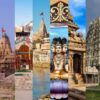The Jyotirlingas are sacred shrines dedicated to Lord Shiva, representing his divine light. These 12 Jyotirlingas are spread across India and are considered some of the most significant pilgrimage destinations for Hindus. Pilgrims believe that visiting these shrines can cleanse their soul, bestow divine blessings, and help them attain spiritual peace. In this blog, we will take you on a journey through each of the 12 Jyotirlingas, with detailed information about the temples, their significance, and the best time to visit.
1. Somnath – Saurashtra, Gujarat
Significance: Somnath is the first Jyotirlinga and is situated in the coastal town of Prabhas Patan, near Veraval. It is dedicated to Lord Shiva and is one of the most historically significant temples in India. Somnath is also known as the “Eternal Shrine” because it has been destroyed and rebuilt several times throughout history.
What to Do: Visit the Somnath Temple, perform aarti, and take a walk along the beautiful beachside.
When it’s Open: The temple is open every day from 6:00 AM to 9:00 PM. The best time to visit is from October to March when the weather is cooler.
Special Events: Somnath sees huge crowds during the annual Maha Shivaratri festival, which is the most auspicious time to visit.
2. Mallikarjuna – Srisailam, Andhra Pradesh
Significance: Mallikarjuna, located in the Srisailam Hills of Andhra Pradesh, is dedicated to Lord Shiva and his consort, Goddess Parvati. The temple is one of the 12 Jyotirlingas and is revered by millions of devotees.
What to Do: Visit the Mallikarjuna Temple, trek the Srisailam hills, and explore the serene surroundings of the Nallamala Forest.
When it’s Open: The temple is open every day from 4:00 AM to 11:00 PM.
Best Time to Visit: November to March, as the weather is more pleasant for travel and pilgrimage.
3. Mahakaleshwar – Ujjain, Madhya Pradesh
Significance: Mahakaleshwar is one of the most revered Jyotirlingas, located in the ancient city of Ujjain in Madhya Pradesh. The temple is situated on the banks of the Shipra River and is famous for its Bhasma Aarti, performed with sacred ashes.
What to Do: Attend the Bhasma Aarti, visit the Mahakaleshwar Temple, and explore the nearby temples of Ujjain.
When it’s Open: The temple is open daily from 4:00 AM to 11:00 PM.
Best Time to Visit: October to March is the ideal time to visit due to the pleasant weather. Devotees flock to the temple during the Kumbh Mela, held once every 12 years.
4. Omkareshwar – Khandwa, Madhya Pradesh
Significance: Omkareshwar is located on an island shaped like the Om symbol on the Narmada River. It is dedicated to Lord Shiva and is a revered site for meditation and devotion.
What to Do: Visit the Omkareshwar Temple, take a boat ride in the Narmada River, and explore the nearby temples.
When it’s Open: The temple is open from 5:00 AM to 9:00 PM.
Best Time to Visit: November to March. The temple is most crowded during Maha Shivaratri.
5. Kedarnath – Kedarnath, Uttarakhand
Significance: Situated in the majestic Himalayas, Kedarnath is one of the Char Dham sites and is dedicated to Lord Shiva. The Kedarnath Temple is one of the most revered and sacred Jyotirlingas.
What to Do: Visit the Kedarnath Temple, trek to the temple (if you are up for the challenge), and enjoy the scenic beauty.
When it’s Open: The temple opens in late April or early May and closes around October due to heavy snowfall. It is open from 4:30 AM to 9:00 PM during the pilgrimage season.
Best Time to Visit: May to October. The temple remains closed in winter due to harsh weather conditions.
6. Bhimashankar – Pune, Maharashtra
Significance: Bhimashankar, located in the Sahyadri range near Pune, Maharashtra, is a popular Jyotirlinga. It is not only a spiritual center but also a part of the biodiversity hotspot with its surrounding forest.
What to Do: Visit the Bhimashankar Temple, explore the nearby wildlife sanctuary, and enjoy the natural beauty.
When it’s Open: The temple is open from 4:00 AM to 9:00 PM.
Best Time to Visit: October to March, especially during the monsoon season when the surroundings are lush and green.
7. Kashi Vishwanath – Varanasi, Uttar Pradesh
Significance: Kashi Vishwanath is one of the most famous Jyotirlingas, located in the holy city of Varanasi. Dedicated to Lord Shiva, it is believed that visiting this temple can cleanse one’s soul and help in attaining moksha.
What to Do: Visit the Kashi Vishwanath Temple, take a boat ride on the Ganges, and attend the Ganga Aarti at Dashashwamedh Ghat.
When it’s Open: The temple is open daily from 2:30 AM to 11:00 PM.
Best Time to Visit: October to March, when the weather is more comfortable for pilgrimage.
8. Trimbakeshwar – Nashik, Maharashtra
Significance: Trimbakeshwar is one of the 12 Jyotirlingas located in the small town of Trimbak, near Nashik. The temple is famous for its three lingas representing the three deities—Brahma, Vishnu, and Shiva.
What to Do: Visit the Trimbakeshwar Temple, take a dip in the holy Godavari River, and explore the surrounding lush hills.
When it’s Open: The temple is open daily from 5:00 AM to 9:00 PM.
Best Time to Visit: October to March. Nashik is a popular destination during the Kumbh Mela, which takes place every 12 years.
9. Vaidyanath – Parli, Maharashtra / Deoghar, Jharkhand
Significance: Vaidyanath is one of the 12 Jyotirlingas and is located at two places—Parli in Maharashtra and Deoghar in Jharkhand. It is dedicated to Lord Shiva as the healer or “Vaidya.”
What to Do: Visit the Vaidyanath Temple, offer prayers, and experience the serenity of the surrounding area.
When it’s Open: The temple is open daily from 5:00 AM to 9:00 PM.
Best Time to Visit: October to March.
10. Nageshwar – Dwarka, Gujarat
Significance: Nageshwar, located near Dwarka, is dedicated to Lord Shiva as Nageshwar, the lord of snakes. It is one of the most revered Jyotirlingas and holds a special place in the hearts of devotees.
What to Do: Visit the Nageshwar Temple, explore the nearby Dwarka beaches, and visit the Dwarkadhish Temple.
When it’s Open: The temple is open from 5:00 AM to 9:00 PM.
Best Time to Visit: October to March.
11. Ramanathaswamy – Rameswaram, Tamil Nadu
Significance: Located on the Pamban Island, Rameswaram is one of the holiest places in India. The Ramanathaswamy Temple is a prominent Jyotirlinga dedicated to Lord Shiva and is associated with the epic Ramayana.
What to Do: Take a holy dip in the Agni Theertham, visit the Ramanathaswamy Temple, and explore the Rameswaram beaches.
When it’s Open: The temple is open from 5:00 AM to 9:00 PM.
Best Time to Visit: October to March.
12. Dwarkadhish – Dwarka, Gujarat
Significance: Dwarkadhish Temple is one of the four sacred Char Dham temples and is dedicated to Lord Krishna, another form of Lord Vishnu. It is also associated with the legend of Lord Krishna’s kingdom.
What to Do: Visit the Dwarkadhish Temple, explore the ancient city of Dwarka, and take a boat ride.
When it’s Open: The temple is open from 6:30 AM to 9:00 PM.
Best Time to Visit: October to March.
Visiting the 12 Jyotirlingas is a spiritual journey that holds immense significance for Hindus. Each of these shrines offers a unique experience and an opportunity to connect with Lord Shiva’s divine light. Be sure to plan your visit around the best times to experience the temples’ tranquility and the surrounding natural beauty. Whether it’s the powerful presence of Lord Shiva or the divine surroundings, these Jyotirlingas offer a transformative experience for every devotee




